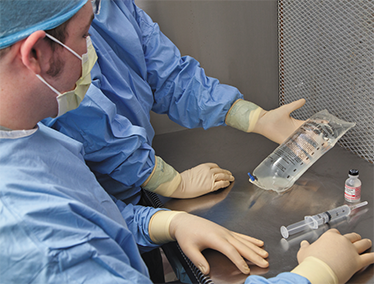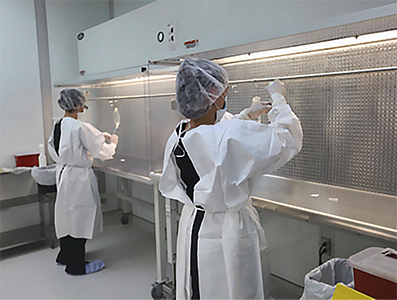12.5 The Need for Sterile Compounding of Drug Products
Many drug products also need to be sterile. Since many medications are for parenteral administration—administered into a vein, muscle, organ, skin, or under the skin—the bacteria or other contaminants in a nonsterile compound could enter into the patient’s body and cause a serious infection, leading to illness and possibly death. Patients often depend for survival upon swift administration of individualized sterile drug products, called compounded sterile preparations (CSPs). A CSP is a medication compounded in a sterile cleanroom environment with sterile instruments and equipment using aseptic technique. These include the following kinds of CSPs:
 Name Exchange
Name Exchange
IV solutions are also known as IV “infusions” and “admixtures.”
Large-volume parenteral (LVP) preparations—IV solutions of more than 250 mL that may contain medications, nutrients, or electrolytes
Small-volume parenteral (SVP) preparations—IV solutions of generally 25 to 250 mL, typically administered as an IV piggyback (infusing into the LVP)
Parenteral nutrition (PN)—specialized LVP solutions that provide nutrition and nutrient requirements to patients who require a long-term alternative to oral and digestive feeding (both supplemental and total parenteral nutrition)
Syringe injections—smaller volume sterile solutions administered via a syringe; IV push, intramuscular (IM), subcutaneous (subq), intradermal (ID), and intrathecal (into protective membrane around the spinal cord)
Noninjected CSPs—miscellaneous sterile solutions that include ophthalmic drops and ointments, aqueous nasal and bronchial inhalations, baths and soaks for live organs, irrigations for wounds and body cavities, tissue implants, and medical imaging diagnostics dyes and tracers
Sterile hazardous drugs (HD)—toxic drugs that are injected into the body, including biological agents; many HDs are chemotherapy medications aimed at killing cancerous cells and destructive tumors
Sterile nuclear drug products—radioactive compounded drugs (such as irradiated iodine) that diagnose and treat various diseases, primarily administered by the IV route
USP Chapter <797> Sterile Compounding Standards
To ensure the safest CSPs, the USP publishes a set of sterile compounding standards in USP Chapter <797> on the preparation of sterile products in the most suitable environment using properly trained personnel and personal protective equipment (PPE), or the proper garb and gear. It outlines how CSPs must be compounded using proper aseptic technique in specially designed and designated rooms that utilize specially filtered air and have specially designed workbenches within which the CSPs are prepared. CSPs are classified into Categories 1 and 2, each with different guidelines for determining their beyond-use date (BUD). The BUD is the date and time after which the CSP may not be used. It is determined by many factors, including the date and time it was compounded, the nature of the product, and the environment in which it was compounded.
USP <797> is frequently revised to reflect new science and information as it becomes available. Once the revised chapter is made available, it is important for all sterile compounding personnel to read it, ask questions as necessary to gain understanding, and then follow all of the standards set forth in the chapter. Until the revised USP <797> is confirmed, it is important to read and follow the guidelines presently in place.
Based on the current USP <797> standards, all sterile compounding facilities are required to establish written standard operating procedures (SOPs) that integrate the guidelines in USP <797> to bring consistency of sterility, accuracy, and quality. The SOPs work to ensure that the entire sterile compounding operation is well designed, functions properly, and yields CSPs that are safe for administration to patients. The SOPs are contained in the pharmacy department’s policy and procedure manual.
All sterile compounding technicians should be so well trained in these SOPs that they can immediately recognize and report any potential problems, deviations, or errors associated with preparing a CSP (related to equipment, facilities, materials, personnel, compounding process, or testing) that might result in contamination or negatively affect the quality of the CSP.
 Practice Tip
Practice Tip
Pharmacy technicians who prepare sterile products are referred to as sterile compounding technicians, IV technicians, or IV admixture technicians.
Sterile Compounding Personnel Credentials and Training
To work in a growing number of sterile compounding facilities and hospitals, you must be a nationally certified pharmacy technician and also obtain additional training for sterile compounding. Most sterile compounding personnel are either required to, or elect to, complete an accredited course in sterile compounding and aseptic technique. Education and training facilities that provide this type of education are generally accredited by the Accreditation Council on Pharmacy Education (ACPE). Training for sterile compounding personnel should include didactic components, such as reading, viewing training videos, classroom instruction, and home-study assignments. It should also include an experiential, hands-on component conducted in the laboratory or simulation environment. Upon completion of your didactic and experiential training, you will undergo written examination and skills process validation procedures. USP <797> sets out the standards for training sterile compounding personnel. The requirements of USP <797> are far more stringent than for nonsterile compounding USP <795> (discussed in Chapter 10).
The USP <797> standards apply to all sterile compounding settings, including hospital compounding pharmacies and nuclear, home health, or infusion pharmacies. When a pharmacy outsources, or sends out, its prescription or medication orders for the preparation of CSPs, the pharmacy must be assured that the outsource facility is meeting all USP <797> requirements to ensure safe, sterile products for administration to their patients.

Technicians preparing IVs, injections, and other CSPs must be carefully trained to follow aseptic technique.
Besides classes and lab training, it is important for aspiring IV technicians to read, understand, and regularly refer to the most recent USP <797> requirements. The competencies that sterile compounding technicians must exhibit are specified in the current version of USP <797>. Sterile compounding personnel must pass written tests and skills assessments at least annually, in addition to completing gloved fingertip sampling and media fill testing twice a year, to provide the evidence needed to meet USP guidelines and Joint Commission accreditation standards.
In addition to knowing well all of the USP <797> guidelines, sterile compounding personnel will utilize some of the same processes as are required in nonsterile compounding (explained in Chapter 10). For example, you must work with a master formulation record, do accurate, exacting calculations and measurements, and compile a compounding record. Some of the USP <797> requirements include being able to demonstrate competency in the following (see Table 12.2):
properly and accurately doing calculations and measurements and following formula directions in precise sequential order
undergoing training and testing in principles and practices of aseptic technique
performing aseptic hand washing and donning appropriate sterile compounding garb
working in a cleanroom environment that meets the USP <797> standards for air quality
disinfecting supplies, equipment, and work surfaces
properly using special equipment and the varied workbench equipment
monitoring environmental quality specifications of airflow, ingredients, and supplies
identifying contamination risk levels and checking beyond-use dating of CSPs
In addition to understanding all of the USP <797> guidelines, sterile compounding personnel will utilize some of the same processes as are required in nonsterile compounding (explained in Chapter 10). For example, you must work with a Master Formulation Record; do accurate, exacting calculations and measurements; and compile a Compounding Record. Some of the USP <797> requirements include beingable to demonstrate competency in the skills listed in Table 12.2.
Table 12.2 Sterile Compounding Skills Proficiencies
|
You must also know and apply the relevant standards for related skills and knowledge contained in the following USP chapters:
<1151> Pharmaceutical Dosage Forms
<1160> Pharmaceutical Calculations in Prescription Compounding
<1163> Quality Assurance in Pharmaceutical Compounding
<1176> Prescription Balances and Volumetric Apparatus
<1191> Stability Considerations in Dispensing Practice
<1265> Written Prescription Drug Information Guidelines
The hospital pharmacy also has its own quality assurance program to ensure that prescription errors do not occur and that high quality CSPs are consistently prepared. Such a program tracks and documents personnel qualifications; drug selection and handling; design, operation, cleanliness, and maintenance of building, facilities, and equipment; compounding processes and aseptic technique; and final CSPs and dispensing processes. The role and duty of each pharmacist and technician involved in the sterile compounding process are carefully delineated in the quality assurance program and the SOPs. The Occupational Health and Safety Administration (OSHA) and your state board of pharmacy also have regulations that must be followed.
The greatest risks of CSP contamination are from failure to follow established procedures and failure to adhere to quality standards. A written training program for each sterile compounding area must be in place to list the requirements and frequency for training as well as processes to evaluate performance.
The hospital pharmacy also has its own quality assurance program to ensure that prescription errors do not occur and that high quality CSPs are consistently prepared. Such a program tracks and documents personnel qualifications; drug selection and handling; design, operation, cleanliness, and maintenance of building, facilities, and equipment; compounding processes and aseptic technique; and final CSPs and dispensing processes. The role and duty of each pharmacist and technician involved in the sterile compounding process are carefully delineated in the quality assurance program and the SOPs. The Occupational Health and Safety Administration (OSHA) and your state board of pharmacy also have regulations that must be followed.

Students at the new, state-of-the-art compounding laboratory at Lipscomb University in Nashville, TN are learning aseptic technique in sterile compounding.